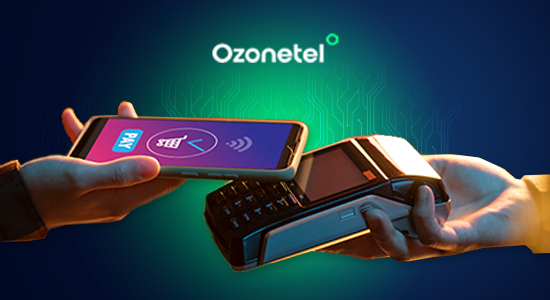- Resources
- Conversational Customer Service: Everything You Need to Know
Conversational Customer Service: Everything You Need to Know

Every business aims to deliver great customer service, but few succeed in doing so. It takes a concerted effort to transform service from transactional to meaningful.
Traditional methods are being complemented by smarter solutions like chatbots and AI, which offer faster, efficient, and more personalized support. Conversational customer service is changing how customers engage with businesses, enabling quick problem solving and better customer experience.
In this article, we will explore:
- 1.What is Conversational Customer Service?
- 2. Traditional vs. Conversational Customer Service
- 3. Benefits of Conversational Customer Service
- 4. Strategies to Improve Conversational Customer Service
- 5.Tips to Deliver Exceptional Omnichannel Customer Experience
- 6.Best Practices in Implementing Omnichannel Strategy
- 7.How to Implement Conversational Customer Service
- 8.Use Cases of Conversational Customer Service
What Is Customer Onboarding?
The customer onboarding process focuses on nurturing new customers—ensuring they are properly set up, familiar with your product, and comfortable using it. The purpose of customer onboarding is to provide value to your consumers as soon as possible so that they continue to return to your product and quickly embrace it as part of their regular work routine.
What is Conversational Customer Service?
Conversational customer service refers to using technology, particularly artificial intelligence (AI) and machine learning (ML), to engage customers in natural, human-like conversations across digital channels. This approach enables businesses to provide immediate, personalized support via chatbots, messaging platforms, and virtual assistants.
As customer expectations shift, many businesses are moving away from traditional customer service models, which often rely on rigid scripts and long wait times. Traditional methods, while still in use, can struggle to meet the growing demand for quick, personalized responses, creating friction in the customer experience.
Conversational customer service addresses this gap by allowing businesses to connect with customers in a way that feels more personal and responsive, providing 24/7 support and reducing the need for manual intervention.
Traditional vs. Conversational Customer Service
Here’s a quick comparison of traditional and conversational customer service:
| Feature | Traditional Customer Service | Conversational Customer Service |
|---|---|---|
| Communication Style | Pre-scripted, standardized replies | Conversational tone with natural language |
| Approach to Engagement | Reactive, addressing issues as they arise | Proactive, anticipating customer needs |
| Channels | Phone calls, emails, and SMS messaging | Social media, chatbots, and messaging platforms |
| Personalization | Generic, one-off interactions | Builds relational, long-term connections |
| Availability | Limited to business hours | Available 24/7 |
| Automation | Limited, mostly automated voice response | Extensive use of AI and automation |
| Scalability | Difficult to scale with rising costs | Handles unlimited simultaneous inquiries |
| Experience | Longer response times | Instant responses |
Benefits of Conversational Customer Service
Conversational customer service helps you meet customer expectations by providing instant support, automating repetitive tasks, and empowering agents to focus on meaningful interactions. Here are the key benefits:
Improved Customer Experience
Conversational customer service offers a seamless way for customers to engage with your brand through their preferred channels, whether it’s chat, messaging apps, or social media. This eliminates long wait times and complex phone menus, giving customers the freedom to get support on their terms.
AI tools enhance this experience by remembering past interactions, offering personalized recommendations, and providing tailored solutions based on customer preferences. For instance, AI can suggest products based on a customer’s previous purchases, making interactions feel more relevant and engaging.
Faster Response Times
With conversational tools like chatbots and virtual assistants, customers can get answers instantly. Studies show that 75% of customers expect a response within five minutes, and conversational customer service tools help meet this demand.
Available 24/7, these solutions offer immediate assistance, no matter the time of day. They can handle a wide range of queries on their own, speeding up response times and reducing customer wait times significantly.
Better Agent Efficiency
Customer service agents often deal with high volumes of repetitive queries, which can overwhelm them and reduce their efficiency. Conversational customer service solves this by automating common interactions and offering self-service options, such as knowledge bases.
This reduces the number of queries that agents need to handle, allowing them to focus on more complex, personalized issues. As a result, agents can work more efficiently, responding to critical requests faster while improving the overall quality of service.
Cost Savings
By automating routine tasks, conversational customer service significantly reduces operational costs. This automation helps reduce the need for extensive training and support staff, allowing businesses to operate more efficiently.
Furthermore, as AI handles common queries, it frees up human agents to focus on higher-value tasks, ultimately lowering both labor and training expenses while still delivering quality service.
Reduced Customer Churn
Customers who experience poor service are more likely to leave for a competitor. However, conversational customer service helps reduce churn by providing fast, personalized, and efficient support. How?
AI-driven solutions allow agents to tailor responses based on customer data, offering a more individualized experience. Additionally, features like chatbots and virtual assistants make conversations more interactive, improving engagement and increasing the likelihood that customers will stay loyal to your brand.
Strategies to Improve Conversational Customer Service
Effective conversational customer service goes beyond just using the right tools. To truly improve customer satisfaction and streamline support, you need a mix of strategies that align with your business needs. Here are some actionable strategies to improve your conversational customer service.
Personalize Interactions
Personalized service boosts customer loyalty. To create more meaningful interactions:
- Use customer data (like order history or preferences) to tailor conversations.
- Encourage your team to greet customers by name and reference past interactions.
- Leverage AI to suggest relevant products or services based on customer activity.
Choose the Right Tools
Picking the right tools helps streamline interactions and improves customer satisfaction. Here’s how to make the best choice:
- Evaluate features like natural language processing and multichannel support.
- Ensure the tool can handle communication on multiple platforms (chat, email, social media) seamlessly.
- Select software that integrates with your existing systems, allowing agents to easily access customer history.
Train and Monitor AI
AI systems need regular updates to stay relevant. To keep your AI effective:
- Continuously train AI with real customer interactions to improve its responses.
- Use supervised learning—have human agents review and refine AI’s responses.
- Test the AI regularly to ensure it’s accurately answering customer inquiries.
Create a Knowledge Base
A well-organized knowledge base can empower customers to resolve issues independently. Here’s how to build one that works:
- Structure your knowledge base with clear categories (FAQs, troubleshooting guides, tutorials).
- Include multimedia, such as videos or step-by-step instructions, for easier navigation.
- Regularly update content based on new product features or customer feedback.
Provide Seamless Handoff
When AI can’t handle an issue, it’s important to transfer the conversation smoothly to a human agent. Here’s how to do it effectively:
- Program AI to recognize when an issue needs human intervention.
- Allow agents to access full conversation history for a seamless transition.
- Ensure the customer doesn’t have to repeat their issue when they are handed off to a human.
Gather and Act on Feedback
Customer feedback drives improvements. To make the most of it:
- Use post-interaction surveys to gather insights on service quality.
- Analyze feedback to identify recurring issues or gaps in service.
- Act on feedback by refining AI responses or improving agent training based on common customer pain points.
Tips to Deliver Exceptional Omnichannel Customer Experience
To deliver an exceptional omnichannel customer experience, focus on creating seamless, personalized, and responsive interactions at every touchpoint. Some tips to help you do this are:
- Ensure Consistent Branding and Messaging: Across all channels, maintain a unified brand voice and consistent messaging to avoid confusing customers. This includes visual elements, tone of communication, and overall customer experience.
- Track Customer Interactions Across Channels: Use integrated customer service tools to collect data on interactions from various touchpoints. This enables your team to offer a personalized, context-aware experience, reducing repetition and enhancing satisfaction.
- Optimize for Mobile Experience: A large portion of customer interactions happens on mobile. Ensure your website, app, and customer service channels are mobile-optimized for a smooth, easy experience.
- Offer Proactive Support: Don’t wait for customers to reach out. Use analytics to anticipate issues or questions and proactively offer help via email, text, or on-site messages.
- Provide Seamless Channel Hopping: If a customer starts an inquiry on one channel, ensure they can seamlessly continue the conversation on another without needing to repeat themselves. This is essential for building trust and convenience.
- Regularly Collect Feedback: Use surveys or post-interaction reviews to gather customer insights. This helps identify pain points and areas for improvement in your omnichannel experience.
Best Practices in Implementing Omnichannel Strategy
The goal of an omnichannel customer service strategy is to provide a consistent, seamless experience across all customer touchpoints, ensuring that your customers have access to the information and support they need, whenever and wherever they choose.
Here are the best practices you should focus on to effectively implement an omnichannel strategy that truly benefits both your business and your customers:
Understand Customer Expectations
Before you can meet or exceed customer expectations, you must first understand them. Each customer interacts with your business differently, and their expectations will vary based on their needs, preferences, and past experiences. A key part of this is understanding their journey across all the touchpoints they use to engage with your business.
For example, some customers may prioritize quick responses via chat, while others might prefer a more personal interaction through email or phone. You can achieve this understanding by gathering and analyzing data on customer behaviors, interactions, and feedback.
Invest in the Right Customer Service Technology
Technology plays an important role in supporting an omnichannel strategy. A customer relationship management (CRM) system, for instance, allows you to collect and centralized customer data, enabling your team to access relevant information at any stage of the customer journey..
Additionally, investing in tools that incorporate artificial intelligence (AI) can significantly streamline operations. Chatbots, for example, can handle common inquiries automatically, reducing response times and freeing up your team to focus on more complex issues.
Identify the Right Channels
While it’s important to be present on popular channels, you also need to explore new ones and stay on top of emerging trends to meet your customers where they are. To do this, consider your target audience and the platforms they engage with most.
For instance, if your customers are primarily young millennials, you may want to focus on social media platforms like Instagram or TikTok. On the other hand, a more professional audience might prefer support via email or even live chat.
Upskill Your Customer Service Team
Your team should be equipped with the knowledge and skills needed to solve complex issues and provide a personal touch when necessary. And to this include product knowledge, effective communication, and problem-solving across different channels. The more your team understands your products and services, the better they’ll be at resolving customer issues.
Implement Self-Service Options
Self-service portals, such as FAQs, knowledge bases, or video tutorials, allow customers to find answers to their questions independently. These tools not only improve customer satisfaction by providing instant support but also reduce operational costs. The more your customers can help themselves, the fewer support requests your team will have to handle.
How to Implement Conversational Customer Service
Conversational customer service can significantly improve response times, reduce operational costs, and provide personalized support. However, its success lies in thoughtful implementation. Here’s how you can implement conversational customer service effectively in your organization:
1.Align All Key Stakeholders
Start by bringing together your operations, product, and customer service teams. Then collaborate with them to identify common customer queries and decide how conversational AI can address them.
This step ensures everyone understands the system’s goals and works toward delivering a unified experience. For example, if your customers frequently ask about delivery timelines, prioritize training your chatbot to handle such inquiries accurately.
2.Choose the Right Tools and Platforms
The success of conversational customer service depends heavily on the tools you use. So, opt for solutions that detect customer sentiments, support seamless cross-channel interactions, and integrate easily with your existing systems.
3.Structure and Prepare Data for AI Training
AI systems need structured data to function effectively – begin by categorizing and labeling customer interaction data to train the model. For example, group inquiries into categories like “Order Status,” “Returns,” or “Payment Issues.” This helps the AI understand queries better and respond appropriately.
4.Map Your Customer Journeys
To understand how customers interact with your brand, map their journey across all channels—website, app, email, or WhatsApp. This helps identify the touchpoints where conversational AI can make the most impact. For instance, if a customer browses products on the website and then messages on WhatsApp, ensure your AI system can pick up the context seamlessly.
5.Focus on Personalizing Customer Interactions
Generic responses frustrate customers so use tools to analyze transaction history, past queries, and preferences to craft personalized replies. For example, if a customer frequently buys a specific product category, recommend similar items during their interaction. Personalized communication enhances engagement and satisfaction.
6.Continuously Improve AI Models
Just implementing conversational AI isn’t enough – regularly monitor performance metrics like customer satisfaction and resolution times. Use these insights to fine-tune responses, retrain AI models, and resolve any identified gaps. For instance, if customers frequently rephrase questions to get clear answers, adjust the training data to handle such variations.
Use Cases of Conversational Customer Service
From automating repetitive inquiries to providing instant assistance across various platforms, conversational AI tools are being widely adopted across industries. Below, we explore compelling use cases where AI-driven chatbots and digital assistants have enhanced customer experiences while improving operational efficiency.
Finance Retail
Muthoot Gold faced the challenge of maintaining engagement with a large customer base while promoting their gold products through a zero-inventory model. Their solution involved Ozonetel’s unified CX platform, including:
- WhatsApp Chatbots and Voice Bots: These tools provided personalized engagement and real-time payment solutions.
- Automated EMI Collection Calls: Over 43,500 calls were made within five months, simplifying payment processes.
- Increased Order Value: Customer trust and seamless digital engagement contributed to a 2.5x rise in average order value.
“Since we follow a zero inventory, phygital model for the jewellery vertical we are indebted to Ozonetel for quickly deploying this tech for our Go To Market strategy.” Haridas P.C., Assistant General Manager, Muthoot Gold Bullion Corp
Banking
One of India’s leading banks fully automated its collection call interactions using Ozonetel’s AI-based voice bot. The bot reminds customers about overdue payments, collects responses, and determines the expected payment date. The AI intelligently decides whether to continue the conversation, reschedule the call, or escalate to a human agent if needed.
Results:
- Automates payment reminders and responses, improving efficiency.
- Accurately assesses customer reactions and adjusts call flow accordingly.
- Uses Natural Language Processing (NLP) to understand complex sentences, slang, and colloquialisms, offering a more natural and flexible interaction.
- Escalates to human agents when necessary, ensuring timely support.
Retail
Decathlon, a leading sporting goods retailer, faced a 4.5X increase in customer inquiries during the spring of 2020. To manage this spike while maintaining high service standards, Decathlon partnered with Heyday, a conversational AI platform.
With Heyday, Decathlon developed a digital assistant capable of understanding over 1000 unique customer intentions and delivering automated responses to questions about sporting goods.
Results:
- 65% of customer inquiries automated, significantly reducing support costs.
- Improved customer satisfaction by handling high volumes effectively.
Transportation
Uber, a global leader in ride-hailing services, made booking rides more convenient by integrating a WhatsApp Chatbot into its customer service. This chatbot allows users to book rides, get fare estimates, and track drivers, all within WhatsApp, eliminating the need to switch apps.
With the chatbot, Uber ensured a seamless and user-friendly experience for its customers.
Results:
- Enabled quick and hassle-free ride bookings.
- Enhanced customer satisfaction by simplifying the process through a familiar platform.
- 24/7 support for uninterrupted assistance.
Education
Duolingo, a leading language-learning platform, introduced a chatbot to make practicing new languages less intimidating and more interactive. Acting as a 24/7 personal tutor, the chatbot engages users in real-life conversations, providing instant feedback and personalized experiences. This AI-powered tool helps users develop conversational skills while enjoying gamified learning.
Results:
- Increased daily active user numbers through engaging and personalized interactions.
- Improved user retention rates by offering real-time support and corrections.
Conclusion
Conversational customer service is about more than just using the latest tools—it’s about creating smooth, personalized interactions that leave customers satisfied. By choosing the right tools, training your team, and continuously improving based on feedback, you can foster meaningful connections with customers. Moreover, using a platform like Ozonetel can simplify these tasks by centralizing communication channels and providing powerful tools to streamline your customer service process.
Want to see what Ozonetel can do for your company? Sign up today for a free 7-day trial.
Prashanth Kancherla
Chief Operating Officer, Ozonetel Communications
Over the past decade, Prashanth has worked with 3000+ customer experience and contact center leaders...
Chief Operating Officer, Ozonetel Communications
Over the past decade, Prashanth has worked with 3000+ customer experience and contact center leaders to comprehensively understand the need for effective and efficient customer communications at every step of their journey with a brand. Deeply embedded in today’s CCaaS ecosystem, he has been instrumental in Ozonetel's growth and contributed in various roles including product management, sales, and solution architecture.
Frequently Asked Questions
The 4 C’s of omnichannel focus on ensuring a seamless and integrated customer experience across all touchpoints. They are:
- Customer: Understanding customer preferences and behaviors to personalize their experience.
- Convenience: Ensuring that customers can easily access services and information, regardless of the channel.
- Consistency: Providing a uniform experience across all channels, so customers receive the same quality of service no matter where they engage.
- Communication: Ensuring effective and clear communication between the business and the customer across all channels.
Netflix’s omnichannel strategy revolves around providing a seamless entertainment experience across multiple platforms, including TV, mobile devices, laptops, and more. The company also ensures consistency in content availability, recommendations, and user preferences, regardless of the device used.
To measure omnichannel customer experience, businesses should track:
- Customer Satisfaction (CSAT): Collect feedback from customers on their experience across different touchpoints.
- Net Promoter Score (NPS): Measure customer loyalty by asking how likely customers are to recommend the brand after interacting with different channels.
- Customer Effort Score (CES): Assess how easy it is for customers to resolve issues or complete tasks across various channels.
- Channel Performance: Monitor the effectiveness of individual channels (e.g., mobile, in-store, online) and their contribution to overall satisfaction.
- Retention Rates: Analyze how well omnichannel strategies influence customer retention and lifetime value.







